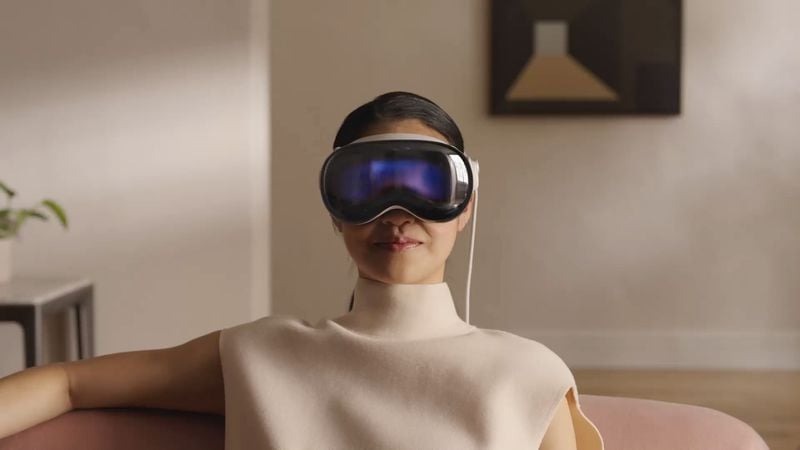Apple‘s infamous secrecy around new products has the tech world whipped into a frenzy speculating if their Vision Pro mixed reality headset will revolutionize immersive computing, or flop as an overpriced gimmick only hardcore fans embrace.
Expected to debut in 2023 for roughly $3,000, no one can decisively conclude yet whether Apple’s dive into augmented and virtual realities will make a seismic impact or sink like a millstone.
This in-depth analysis examines both bull and bear cases to determine if Apple’s Vision Pro headset lives up to the hype or disappoints.
The Potential Game-Changing Upsides
First, let’s scrutinize reasons for enthusiasm around the Vision Pro headset and where Apple may again catalyze the next computing revolution.
Cutting-Edge Hardware Leaps
Apple invests astronomical resources perfecting product design and hardware engineering few rivals can match. Their track record for relentless innovation remains outstanding.
Early reports on Apple’s VR/AR headset impress in this dimension with expected capabilities like:
- Dual super high-res 4K microOLED displays
- 140+ degree field-of-view
- HDR video support with extreme brightness/contrast
- Advanced eye-tracking sensors
- Spatial audio for immersive sound
- Incredibly powerful standalone computing
These represent massive technical breakthroughs beyond existing platforms today in critical areas like visual fidelity, immersion and mobility.
Deep OS/Ecosystem Integration
Hardware however only forms one part of the equation. Apple’s greatest strengths shine through deeply fusing their operating systems with hardware innovations.
Expectations remain high around the Vision Pro debuting a new realityOS platform marking Apple’s next evolution beyond iOS and macOS. Tight integration with ubiquitous iPhone and Mac products could prove seriously compelling.
Additionally, Apple is in prime position to leverage vast App Store resources making realityOS an rich ecosystem for developers, opening unlimited potential. This lays the groundwork for mass adoption beyond gaming and entertainment into healthcare, design, manufacturing and more.
Cross-Dimensional Interactions
Unlike existing VR headsets disconnecting users from the outside world, Apple’s purported mixed reality approach aims to seamlessly blend both physical and digital – coined the “blended reality wave” by Apple insider Ming-Chi Kuo.
Early patent filings depict a Vision Pro experience where virtual elements get overlaid into real-world environments for a more natural human-computer interface. Sensors would allow manipulating holograms with gestures and interacting collabarily with remote users simultaneously.
If executed properly, Apple could pioneer a new paradigm in spatial computing that feels significantly less isolating and more intuitive than today’s VR.
The Case of Being Potentially Underwhelmed
However, for all the reasons to cheer Apple redefining reality as we know it, ample doubts remain around whether the Vision Pro will realistically achieve mainstream appeal anytime soon.
$3,000 Price Tag Limits Addressable Market
Priced as expected at roughly $3,000, Apple’s Vision Pro costs over 6X more than Meta’s leading Quest Pro headset today targeting professionals. And Meta struggles massively already with VR adoption and profitability.
Early Apple products often launch exorbitantly high, but questions abound whether enterprises or consumers uptake an largely unproven VR/AR device at this cost level.
For comparison, fewer than 2% of US smartphones sold in Q1 2022 retailed over $1,500. That signals extreme niche demand for mobile devices in the price bracket Apple eyes for launch.
New Interaction Paradigms Always Polarizing
History shows Apple indeed catalyzes entirely new computing revolutions – the Macintosh, iPod, iPhone. But all initially faced heavy skepticism before mainstream acceptance.
Early adopters warm quickly to unfamiliar interaction modalities like touchscreens, but ease-of-use challenges plagued first-gen products. Could blended reality prove too spatial, too unfamiliar, too isolated for average consumers to embrace?
Many struggle even getting accustomed to stereoscopic 3D effects in current headsets. Microsoft’s HoloLens demonstrates enterprise mixed reality disinterest despite a decade of attempts at varied form factors and price points. What evidence supports Apple sidestepping similar barriers in Phase 1?
All-New App Platform Poses Major Challenges
Lastly, the Vision Pro hinges tremendously on seeding a flourishing new app ecosystem, but that too poses thorny challenges.
Developers already stretched thin on resources must climb completely new learning curves around blending realities, spatial interfaces, immersive environments. Without their support en masse, any new platform risks being all dressed up with nowhere to go.
Hardware and OS mean nothing absent killer apps showcasing true game-changing use cases. Can Apple build enough developer momentum fast enough around realityOS to escape this chicken-and-egg problem that often plagues new platforms?
Vision Pro: Revolutionary or Red Herring?
Exhilaration and apprehension both permeate any transformative new product launch. And they permeate equally around the Vision Pro today.
Apple’s crown-jewel status launching category-defining products compels rosy optimism by historical standards.
Yet VR and ARs persistent challenges gaining adoption among enterprises and consumers generates understandable caution around proclaiming the Vision Pro an unequivocal hit.
In the end, predicting any ground-floor innovation’s success holds no guarantees. The Vision Pro indeed may lift mixed reality to prominence after years of dull reactions.
But it may also demonstrate again how regular folks still show little appetite wearing computers on heads – no matter how magical Apple crafts the experience or advanced the technology.
For tech investors and enthusiasts, observing it all play out promises high entertainment regardless. Just try to separate hype from reality where possible.
Will you buy Apple’s Vision Pro headset? Why or why not? Share your thoughts below!










Add Comment